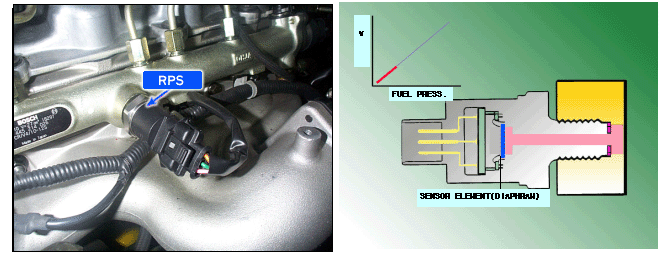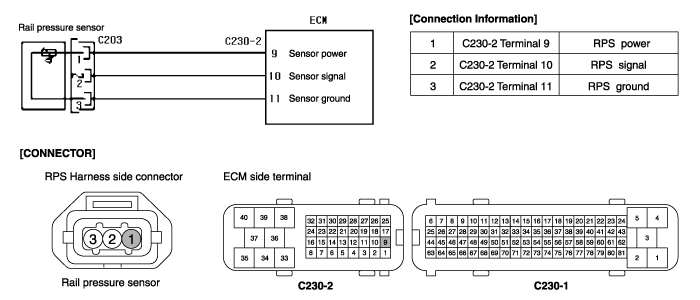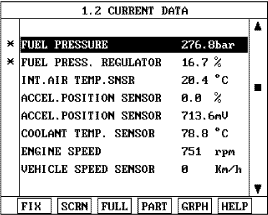Has a problem been found?

Repair as necessary and go to "Verification of Vehicle Repair" procedure.

Go to "Power Circuit Inspection" procedure.

RPS(Rail Pressure Sensor) used to transmit to the ECM the pressure value for the rail. The rail is a high pressure accumulator. In order to output a voltage signal to the ECM which is directly proportional to the applied pressure,the rail pressure sensor must measure the instaneous pressure in the rail.
The fuel flows to the rail pressure sensor through opening in the rail, the end of which is sealed off by the sensor diaphram.
Pressurized fuel reaches the sensor's diaphram through a blind hole.
The sensor element (semi conductor device) for convertering the pressure to an electric signal is mounted on this diaphram.
The signal generated by the sensor is inputted to an evaluation circuit which amplifies the measuring signal and sends it to the ECM. This value is used in calculating the flow and injection advance.
In case of RPS failure, the engine symptoms will occur the running engine stall and the starting impossible.
If the signal exceeds threshold value, the ECM judged this as a fault and DTC is set.
Item | Detecting Condition | Possible Cause |
DTC Strategy | ● Voltage range check | ● Short to ground power circuit ● Short to battery in power circuit ● Open in power ● Faulty RPS ● Faulty ECM |
Enable Conditions | ● Engine run | |
Threshold Value | ● 4.7 V < Sensor supply voltage < 5.1 V | |
Diagnostic Time | ● 0.1 sec. | |
MIL Fuel Limit Fuel Cut EGR Off | ● Yes ● Yes ● No ● No | |
Fail safe | ● Rail pressure is fixed at value of 400 bar by ECM. ● Engine shut down ● Starting impossible |
RPS | ||
Engine idle state | Fully acceleration (100%) | |
Rail Pressure | 220 ~ 320 bar (22 ~ 32 Mpa) | 1500 bar (150 Mpa) |
Signal Voltage | Below 1.7 V | Approx. 4.5 V |


Connect scantool to Data Link Cable (DLC).
Warm up engine to normal operating temperature.
Monitor "Fuel Pressure Sensor" parameter on the scantool.

Fig 1) Normal value at idle speed.
Is the Current data displayed correctly ?

Fault is intermittent caused by poor contact in the sensor’s and/or ECM’s connector or was repaired and ECM memory was not cleared. Thoroughly check connectors for looseness, poor connection, bending, corrosion, contamination, deterioration, or damage. Repair or replace as necessary and go to "Verification of Vehicle Repair" procedure.

▶ Go to "W/Harness Inspection" procedure.
Many malfunctions in the electrical system are caused by poor harness and terminals.
Faults can also be caused by interference from other electrical systems, and mechanical or chemical damage.
Thoroughly check connectors for looseness, poor connection, bending, corrosion, contamination, deterioration, or damage.
Has a problem been found?

Repair as necessary and go to "Verification of Vehicle Repair" procedure.

Go to "Power Circuit Inspection" procedure.
Check for short in harness
Ignition "OFF"
Disconnect FT sensor connector
Ignition "ON" & Engine "OFF"
Measure voltage between terminal 1 of the sensor harness connector and chassis ground
Specification : 5V

Is the measured voltage within specifications ?

▶ Go to "Ground Circuit Inspection" procedure.

▶ Check for short to battery in harness. Repair as necessary and go to "Verification of Vehicle Repair" procedure
Check for open in harness
Ignition "OFF"
Disconnect FT sensor connector
Measure resistance between terminal 1 of the sensor harness connector and terminal 9 of ECM harness connector.
Specification : Approx. below 1Ω

Visual inspection
Check installation torque and leakage around Fuel Rail Pressure Sensor.
Check for damaged harness and terminals: contact resistance, oxidation, bent or broken terminals.
Check deform or crack on Fuel Rail Pressure Sensor.
Installation Torque : 35 ± 2 Nm
Is the Fuel Rail Pressure sensor visually O.K ?

▶ Substitute with a known-good ECM and check for proper operation.
If the problem is corrected, replace ECM and then go to "Verification of Vehicle Repair" procedure.

▶ Substitute with a known-good Fuel Rail Pressure Sensor and check for proper operation.
If the problem is corrected, replace Fuel Rail Pressure Sensor and then go to "Verification of Vehicle Repair" procedure.
After a repair, it is essential to verify that the fault has been corrected.
Connect scan tool and select "Diagnostic Trouble Codes(DTCs)" mode and then clear DTC.
Operate the vehicle within DTC Enable conditions in General information.
Are any DTCs present ?

Go to the applicable troubleshooting procedure.

System is performing to specification at this time.